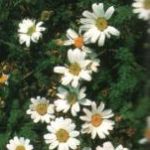| Common Name: |
Pellitory |
| Other Names: |
Pellitory of Spain |
| Botanical Name: |
Anacyclus pyrethrum |
| Genus: |
Anacyclus |
| Family: |
Asteraceae |
| Native Location: |
Spain, Algeria, and Morocco |
| Cultivation: |
Well-drained soil in sun. Dislikes wet winters. |
| Propagation: |
By seed sown in autumn; by softwood cuttings in spring or early summer. |
| Harvest: |
Roots are lifted in autumn, then dried and powdered or made into decoctions, lozenges, and tinctures. |
| Variations: |
Depressus
Has a low-growing, compact habit and white ray petals with red undersides.
Height: 2.5-5cm (1-2in)
Width: 10cm (4in) |
| Height: |
30cm (12in) |
| Width: |
25-30cm (10-12in) |
| Hardiness: |
Z6-10 |
| Parts Used: |
Roots
Various parts of the entire plant, frequently differing by country and culture |
| Chemical Constituents: |
Pellitorine |
| Properties: |
A pungent, acrid herb that stimulates the salivary glands and irritates the tissues, thereby increasing blood flow to the area. |
| Known Effects: |
Kills insects.
Miscellaneous Information:
Tastes bitter. |
| Possible Additional Effects: |
May relieve pain from toothache or gum infections
May relieve facial pain
May increase saliva flow
|
| Medicinal Uses: |
Externally for toothache, facial neuralgia, and chronic mucus. |
| Culinary Uses: |
Essential oil from roots is used in liqueurs. |
| Warnings and Precautions: |
Don't take if you:
Are pregnant, think you may be pregnant, or plan pregnancy in the near future
Have any chronic disease of the gastrointestinal tract, such as stomach or duodenal ulcers, reflux esophagitis, ulcerative colitis, spastic colitis, diverticulosis or diverticulitis
Consult your doctor if you:
Take this herb for any medical problem that doesn't improve in 2 weeks (There may be safer, more effective treatments.)
Take any medicinal drugs or herbs including aspirin, laxatives, cold and cough remedies, antacids, vitamins, minerals, amino acids, supplements, other prescription or non-prescription drugs
Pregnancy:
Don't use unless prescribed by your doctor.
Breastfeeding:
Don't use unless prescribed by your doctor.
Infants and Children:
Treating infants and children under 2 with any herbal preparation is hazardous.
Others:
None are expected if you are beyond childhood, under 45, not pregnant, basically healthy, take it only for a short time and do not exceed manufacturer's recommended dose.
Storage:
Store in cool, dry area away from direct light, but don't freeze.
Store safely out of reach of children.
Don't store in bathroom medicine cabinet. Heat and moisture may change the action of the herb.
Safe Dosage:
Consult your doctor for the appropriate dose for your condition.
|
| Adverse Reactions, Side Effects, or Overdose Symptoms: |
| Signs and Symptoms |
What to Do |
|
| Diarrhea |
Discontinue. Call doctor immediately. |
| Nausea or Vomiting |
Discontinue. Call doctor immediately. |
|
| Bibliography: |
Encyclopedia of Herbs by Deni Brown Copyright © 1995, 2001 Dorling Kindersley Limited Pg 119
Vitamins, Herbs, Minerals & Supplements The Complete Guide by H. Winter Griffith, MD Copyright©1998 Fisher Books pp. 408-409 |

